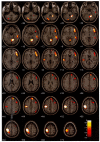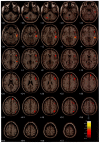Hemispheric differences in hemodynamics elicited by auditory oddball stimuli
- PMID: 15955488
- PMCID: PMC2759643
- DOI: 10.1016/j.neuroimage.2005.02.044
Hemispheric differences in hemodynamics elicited by auditory oddball stimuli
Abstract
Evidence from neuroimaging studies suggests that the right hemisphere of the human brain might be more specialized for attention than the left hemisphere. However, differences between right and left hemisphere in the magnitude of hemodynamic activity (i.e., 'functional asymmetry') rarely have been explicitly examined in previous neuroimaging studies of attention. This study used a new voxel-based comparison method to examine hemispheric differences in the amplitude of the hemodynamic response in response to infrequent target, infrequent novel, and frequent standard stimuli during an event-related fMRI auditory oddball task in 100 healthy adult participants. Processing of low probability task-relevant target stimuli, or 'oddballs', and low probability task-irrelevant novel stimuli is believed to engage in orienting and attentional processes. It was hypothesized that greater right-hemisphere activation compared to left would be observed to infrequent target and novel stimuli. Consistent with predictions, greater right hemisphere than left frontal, temporal, and parietal lobe activity was observed for target detection and novelty processing. Moreover, asymmetry effects did not differ with respect to age or gender of the participants. The results (1) support the proposal that the right hemisphere is differentially engaged in processing salient stimuli and (2) demonstrate the successful use of a new voxel-based laterality analysis technique for fMRI data.
Figures


Similar articles
-
Right hemisphere dominance for auditory attention and its modulation by eye position: an event related fMRI study.Restor Neurol Neurosci. 2007;25(3-4):211-25. Restor Neurol Neurosci. 2007. PMID: 17943000
-
Visual attention circuitry in schizophrenia investigated with oddball event-related functional magnetic resonance imaging.Am J Psychiatry. 2007 Mar;164(3):442-9. doi: 10.1176/ajp.2007.164.3.442. Am J Psychiatry. 2007. PMID: 17329469
-
An adaptive reflexive processing model of neurocognitive function: supporting evidence from a large scale (n = 100) fMRI study of an auditory oddball task.Neuroimage. 2005 Apr 15;25(3):899-915. doi: 10.1016/j.neuroimage.2004.12.035. Neuroimage. 2005. PMID: 15808990
-
An FMRI auditory oddball study of combined-subtype attention deficit hyperactivity disorder.Am J Psychiatry. 2007 Nov;164(11):1737-49. doi: 10.1176/appi.ajp.2007.06050876. Am J Psychiatry. 2007. PMID: 17974940
-
Laterality of Brain Activation for Risk Factors of Addiction.Curr Drug Abuse Rev. 2016;9(1):1-18. doi: 10.2174/1874473709666151217121309. Curr Drug Abuse Rev. 2016. PMID: 26674074 Free PMC article. Review.
Cited by
-
Assessing the spatiotemporal evolution of neuronal activation with single-trial event-related potentials and functional MRI.Proc Natl Acad Sci U S A. 2005 Dec 6;102(49):17798-803. doi: 10.1073/pnas.0505508102. Epub 2005 Nov 28. Proc Natl Acad Sci U S A. 2005. PMID: 16314575 Free PMC article.
-
Spatial neglect and attention networks.Annu Rev Neurosci. 2011;34:569-99. doi: 10.1146/annurev-neuro-061010-113731. Annu Rev Neurosci. 2011. PMID: 21692662 Free PMC article. Review.
-
Brain correlates of emotional prosodic change detection in autism spectrum disorder.Neuroimage Clin. 2020;28:102512. doi: 10.1016/j.nicl.2020.102512. Epub 2020 Nov 27. Neuroimage Clin. 2020. PMID: 33395999 Free PMC article.
-
Tuning to Binaural Cues in Human Auditory Cortex.J Assoc Res Otolaryngol. 2016 Feb;17(1):37-53. doi: 10.1007/s10162-015-0546-4. J Assoc Res Otolaryngol. 2016. PMID: 26466943 Free PMC article.
-
The lateralized cerebellum: insights into motor, cognitive, and affective functioning across ages: a scoping review.J Neurol. 2025 Jan 15;272(2):122. doi: 10.1007/s00415-024-12884-2. J Neurol. 2025. PMID: 39812809
References
-
- Aguirre GK, Zarahn E, D'Esposito M. The inferential impact of global signal covariates in functional neuroimaging analyses. NeuroImage. 1998;8:302–306. - PubMed
-
- Alain C, Cortese F, Picton TW. Event-related brain activity associated with auditory pattern processing. NeuroReport. 1998;9:3537–3541. - PubMed
-
- Alexander JE, Bauer LO, Kuperman S, Morzorati S, O'Connor SJ, Rohrbaugh J, Porjesz B, Begleiter H, Polich J. Hemispheric differences for P300 amplitude from an auditory oddball task. Int. J. Psychophysiol. 1996;21:189–196. - PubMed
-
- Allen G, Buxton RB, Wong EC, Courchesne E. Attentional activation of the cerebellum independent of motor involvement. Science. 1997;275:1940–1943. - PubMed
-
- Anderer P, Semlitsch HV, Saletu B. Multichannel auditory event-related brain potentials: effects of normal aging on the scalp distribution of N1, P2, N2 and P300 latencies and amplitudes. Electroencephalogr. Clin. Neurophysiol. 1996;99:458–472. - PubMed
Publication types
MeSH terms
Grants and funding
LinkOut - more resources
Full Text Sources

